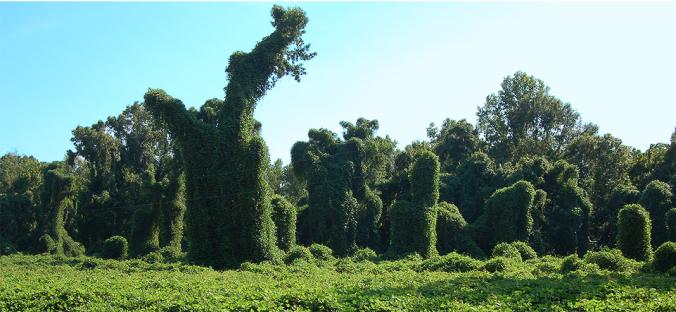
I’m writing this at my house in central Connecticut. Twenty thousand years ago, this spot was buried under a mile of ice.
About thirteen thousand years ago, after the ice thinned and retreated, plants swept over the bare land. They came from the southern United States, and they established the same kinds of forests and swamps that had grown in Connecticut in earlier periods between the Ice Ages.
But today, many of the most abundant plants around my house today come from distant continents–plants like honeysuckle. And Japanese barberry. And ground ivy. And the knotweed. And on and on: you can read a list of invasive plants in Connecticut here.
It’s a story repeated around the world. As ships cross the oceans and planes soar through the air, they deliver species to places that would probably never get to on their own. And sometimes they thrive amazingly, beating back the native species.
This week in the New York Times, I write about new research on why invasive species thrive. Some scientists argue that native ecosystems have to be weakened for aliens to take hold. Some favor the idea that alien species gain an advantage by leaving their parasites and predators behind. But a pair of ecologists, Jason Fridley and Dov Sax, argue that something else may be going on. It may simply be that the invasive species are superior.
Using the word “superior” is a risky thing to do, because it can trigger lots of troublesome and irrelevant associations…
@carlzimmer @nytimesscience You mean with traits having more survival value? “Biologically superior” is so 1930’s.
— MICHAEL SAUKA (@tc99mman) October 9, 2014
But the word is correct–Fridley and Sax use it repeatedly in their paper–so I’ll stand by it even if it means I have to clarify things.
Fridley and Sax have drawn on some remarks by Darwin to develop what they call the Evolutionary Imbalance Hypothesis. They argue that species in different parts of the world have adapted to similar physical conditions. East Asia is a lot like Connecticut, for example, in terms of its climate. The species in both places have evolved, as natural selection improved their ability to survive, grow, and reproduce. It’s conceivable that a species in one place might get better at all that than a species somewhere else. It would be, in other words, superior. That doesn’t mean that this species would be some kind of Platonic ideal, or that it was a kind of Aryan paragon. It simply produced more offspring under identical conditions than another species.
Fridley and Sax hypothesized that some places might act as nurseries for superior species. These would be stable regions where evolution could play out longer than other places. As I describe in my column, they found evidence that these places–like East Asia–do in fact exist, and they send lots of invasive species to other regions. Like Connecticut. With ice sheets sweeping down from time to time, Connecticut and the rest of the northeastern United States may have been home to an ecosystem of–sorry to say–inferior species.
As I noted in my column, this hypothesis has some gloomy implications for those who want to preserve native species. Healing a native ecosystem may not be enough. Introducing an alien species’s parasites to its new range may not be enough. That’s because fighting invasive species may, in effect, be fighting against millions of years of evolution.
And this leads to a prickly question. One of the things that make ecosystems worth saving is the services they provide us with. If a superior species swoops in, it may do a better job at some of those services than native ones. An alien plant might draw more carbon dioxide out of the atmosphere and store it away in the soil, for example. Maybe we’ll be better off with an invaded ecosystem? I may not be fond of the barberry infiltrating the New England forests, but maybe our decisions about managing the wilderness have to be based on more than aesthetics.